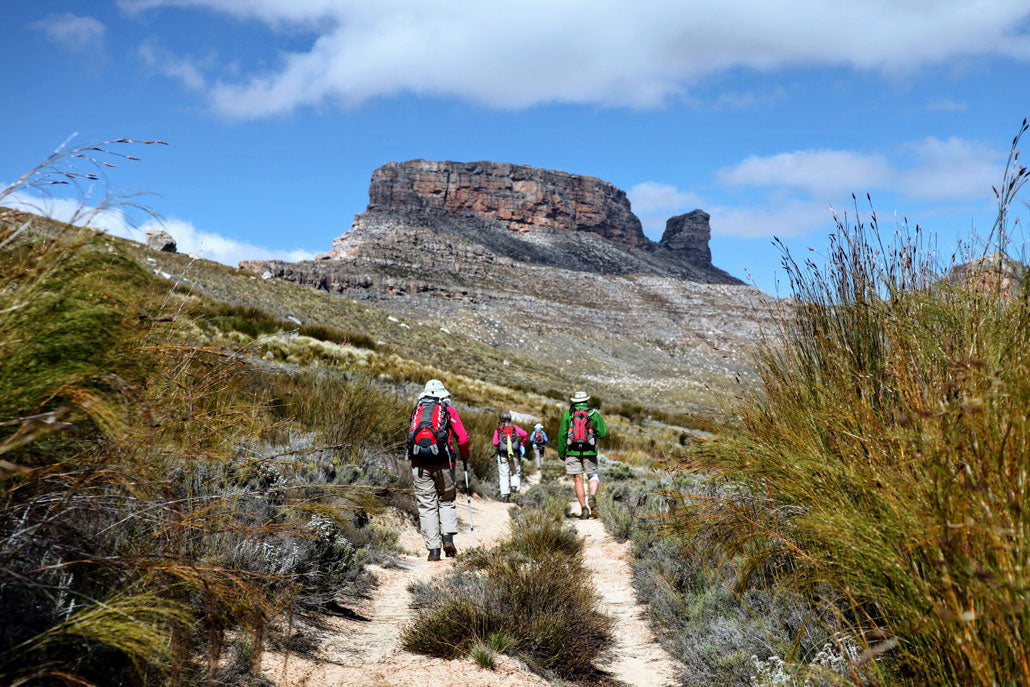
Rim of Africa | Traverse 1
Share
Jess Tyrrell, one of the guides on the Rim of Africa hike, gives us a beautiful overview of the first section of South Africa’s longest mountain hike – a fantastic hike for those who have carried a pack before for several days and would like to try their hand at a week-long traverse with a sense of adventure.
Beauty: 5/5
Difficulty: 7/10
Technical rating: Standard trail walking with some off-trail sections, minor scrambling, and river crossings.
Duration: 7 days
Day 1
The start of the Rim of Africa. Despite its intimidating reputation as a challenging 9-week journey along the Cape Fold Mountains, this first day begins gently. It’s a relaxed introduction — a slow meander to stretch the legs, climbing up to the top of Pakhuis Pass where we join the old donkey cart route that once led to Heuningvlei. Instead, we leave the path, tuck behind rocks among a grove of yellowwoods, and settle into our first camp beneath the stars.
 Camping is the name of the game – all hikers carry their own tents and provisions for 4–5 days at a time.
Camping is the name of the game – all hikers carry their own tents and provisions for 4–5 days at a time.
Day 2
In the distance, we glimpse the tiny settlement of Heuningvlei before it disappears as we head deeper into the Cederberg. We pass groves of cedar trees, some marked with leopard claw scratches, and drink from clear mountain streams. Lunch is enjoyed under the shade of giant wabooms, followed by a swim in icy, crystal-clear pools — because “you never regret a swim.” The day’s walking is moderate, with one long ascent and a delightful stretch through fynbos in full flower.

Day 3
We weave through sculpted red and orange sandstone formations, beneath cedar canopies, and through narrow valleys guarded by towering cliffs. A steep climb leads us to a stream-side tea break — water fresh from the mountains above. From the summit, breathtaking views of the Red Cederberg unfold. The descent is steep and overgrown, reminding us how remote this terrain is. Patches of arum lilies surprise us as we lose altitude. That night, we camp high up with Clanwilliam Dam a sliver on the western horizon.


Day 4
Today’s route meanders through dramatic sandstone spires and caves that hint at ancient human life — rock art and echoes of a hunter-gatherer existence. It’s a day of connection to nature and heritage. The terrain undulates gently, with one afternoon climb. We end the day camping near the base of Tafelberg, surrounded by red rock and ancient silence.
 Walking towards the famed Tafelberg in the Cederberg on Day 4.
Walking towards the famed Tafelberg in the Cederberg on Day 4.
Day 5
We descend into a river valley, pushing through dense reed beds in search of crossing points. Laughter fills the air as hikers call out when they find a good route across the hidden water. Lunch is beneath a great oak tree before we head up toward Sneeuberg, where we camp beneath its looming slopes for the night.

 Time for solitude at the end of a long hiking day. Image: Anja Wiehl
Time for solitude at the end of a long hiking day. Image: Anja Wiehl
Day 6
We pass the iconic Maltese Cross before traversing massive amphitheatres and secluded kloofs. Hardly anyone walks here, and it feels like a forgotten world. We trace the remnants of the Ou Kaapse Weg — the old ox-wagon route that once connected the Cape to the interior. A short, steep descent demands some bundu-bashing and concentration, but it’s rewarding. We camp beside a golden-tinged river, its Palmiet-lined banks glowing at sunset.

 Turning south on Day 6 – panoramic views towards the west show why it’s called the Rim of Africa.
Turning south on Day 6 – panoramic views towards the west show why it’s called the Rim of Africa.
Day 7
The Middleberg Pass lies ahead. We descend through farmland, tackling a final off-path section — a steep but thrilling scramble that ends in high fives at the bottom. A cooling swim in the river marks the perfect finish before we stroll through fruit orchards to the base of the pass. The Koue Bokkeveld awaits, and with it, Traverse 2 of the Rim of Africa.

For more information, visit rimofafrica.co.za.
